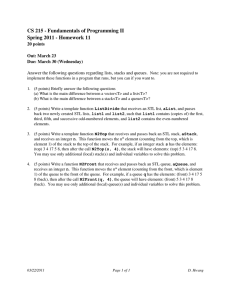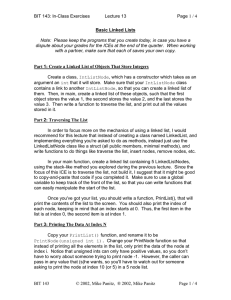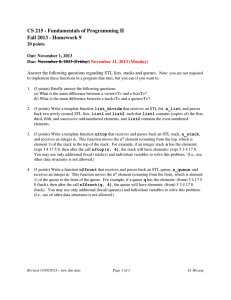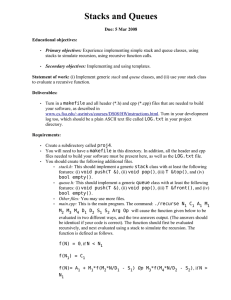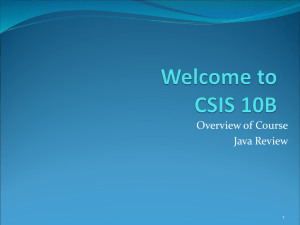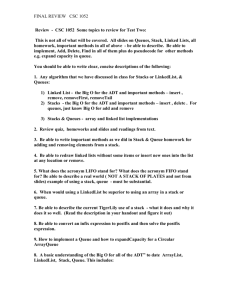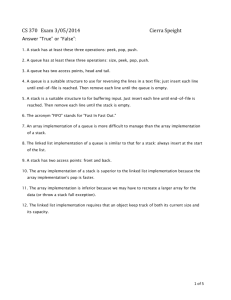ICE : Stacks Queues
advertisement
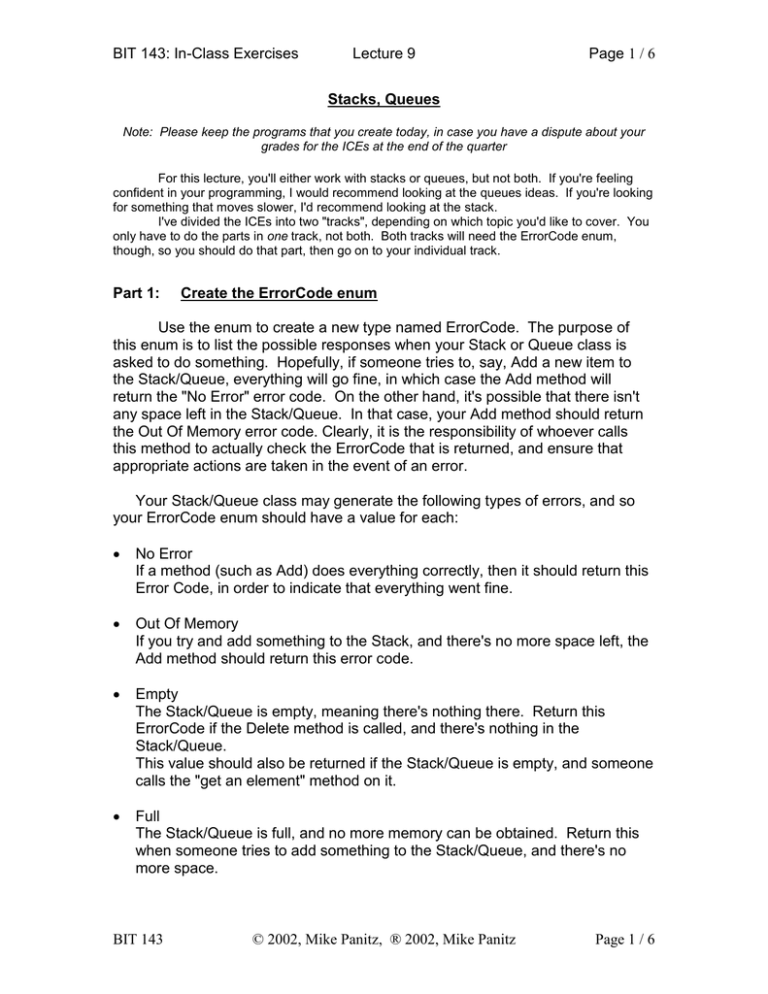
BIT 143: In-Class Exercises
Lecture 9
Page 1 / 6
Stacks, Queues
Note: Please keep the programs that you create today, in case you have a dispute about your
grades for the ICEs at the end of the quarter
For this lecture, you'll either work with stacks or queues, but not both. If you're feeling
confident in your programming, I would recommend looking at the queues ideas. If you're looking
for something that moves slower, I'd recommend looking at the stack.
I've divided the ICEs into two "tracks", depending on which topic you'd like to cover. You
only have to do the parts in one track, not both. Both tracks will need the ErrorCode enum,
though, so you should do that part, then go on to your individual track.
Part 1:
Create the ErrorCode enum
Use the enum to create a new type named ErrorCode. The purpose of
this enum is to list the possible responses when your Stack or Queue class is
asked to do something. Hopefully, if someone tries to, say, Add a new item to
the Stack/Queue, everything will go fine, in which case the Add method will
return the "No Error" error code. On the other hand, it's possible that there isn't
any space left in the Stack/Queue. In that case, your Add method should return
the Out Of Memory error code. Clearly, it is the responsibility of whoever calls
this method to actually check the ErrorCode that is returned, and ensure that
appropriate actions are taken in the event of an error.
Your Stack/Queue class may generate the following types of errors, and so
your ErrorCode enum should have a value for each:
No Error
If a method (such as Add) does everything correctly, then it should return this
Error Code, in order to indicate that everything went fine.
Out Of Memory
If you try and add something to the Stack, and there's no more space left, the
Add method should return this error code.
Empty
The Stack/Queue is empty, meaning there's nothing there. Return this
ErrorCode if the Delete method is called, and there's nothing in the
Stack/Queue.
This value should also be returned if the Stack/Queue is empty, and someone
calls the "get an element" method on it.
Full
The Stack/Queue is full, and no more memory can be obtained. Return this
when someone tries to add something to the Stack/Queue, and there's no
more space.
BIT 143
© 2002, Mike Panitz, ® 2002, Mike Panitz
Page 1 / 6
BIT 143: In-Class Exercises
Lecture 9
Page 2 / 6
Track 1: Stack
Part 1:
Creating a Basic Stack Class
You should create a Stack class, which will hold ints. It's fine to start with
an array whose size is set at compile time (rather than dynamically setting the
size at runtime).
The class declaration should look like:
class StackOfInts
{
public:
// Ctor initializes each individual object.
StackOfInts();
// The dtor for this class doesn't really need to do
// anything... yet
~StackOfInts();
// Add will attempt to add newItem to the top of the
// Stack.
ErrorCode AddToTop(int newItem);
// getTopItem is given the address of an integer
// It then copies the int at the front of the Stack
// into that integer.
// It'll return the "Stack Empty" ErrorCode if the
// Stack is empty
ErrorCode getTopItem(int *pTopItem);
// Delete will remove the front item from the Stack.
// It'll return the "Stack Empty" ErrorCode if the
// Stack is empty
ErrorCode RemoveFromTop();
// isEmpty returns true if the Stack is empty
// false otherwise
bool isEmpty();
// This is a method for debugging purposes:
// It should print out all the numbers stored in
// the stack, indicating which is the topmost item
// and which is the bottommost.
void Print();
private:
BIT 143
© 2002, Mike Panitz, ® 2002, Mike Panitz
Page 2 / 6
BIT 143: In-Class Exercises
Lecture 9
Page 3 / 6
int StackItems[2];
// These will have to be given starting values
// in the constuctor.
unsigned int topIndex;
};
For a problem like this, I'd recommend using the same strategy as you
used last class: starting with the method that will be the more central to the data
type, and then working outwards from there.
You should test out your Stack class by instantiating one in main, and
calling each of it's methods at least once. Make sure that your Stack deals with
erroneous situations properly: try to getFrontItem / Delete on an empty Stack, or
to Add three integers to the Stack. Notice that by choosing a small value for the
size of the Stack, these are very easy to test. When you actually go to use the
Stack in an application, you can adjust the size upwards.
Part 2:
Creating A Dynamically Sized Stack
Modify what you're written in the previous part, so that instead of using the
static array (with a size of 2), the stack will dynamically allocate an array of
integers, with the size set by the creator of the object. The creator will pass an
integer argument, representing the largest number of ints that the stack will hold
at any one time, to a constructor. At the same time, you should continue to
provide a default constructor – either through overloading the constructor, or
through default arguments.
Part 3:
A Stack of Pointers To Objects
Now that you've seen how to create an array of pointers to objects, copy
your StackOfInts class, and modify the copy. First, rename it StackOfPersons,
and then modify it so that it instead of being a stack of ints, it should be a stack of
pointers to Person objects (if you've created another class that you'd rather use
instead, feel free to use that). Make sure that this works by testing it, in main.
For example, you might write code that looks like:
#define STACK_SIZE 5
void main (void)
{
StackOfPersons stack(STACK_SIZE);
Person *pNewObject;
for(int i = 0; i < STACK_SIZE; i++)
{
BIT 143
© 2002, Mike Panitz, ® 2002, Mike Panitz
Page 3 / 6
BIT 143: In-Class Exercises
Lecture 9
Page 4 / 6
if (i % 2 == 0) // If it's even, make an operand
pNewObject = new Person( 3.7, "Fred" );
else // Make an operator
pNewObject = new Person ( 1.4, "Bob" );
if (pNewObject == NULL)
exit(-1);
stack.AddToTop(pNewObject);
cout << "Added to the stack: << endl;
pNewObject->Print();
}
cout << "Current State of the Stack:" << endl;
stack.Print();
stack.RemoveTopItem();
cout << "Current State of the Stack:" << endl;
stack.Print();
// etc., etc.
}
Track 2: Queue
Part 1:
Creating a Basic Queue Class
You should create a Queue class, which will hold ints. It's fine to start
with an array whose size is set at compile time (rather than dynamically setting
the size at runtime). Also, implement a normal queue, not a circular queue.
The class declaration should look like:
class QueueOfInts
{
public:
// Ctor initializes each individual object.
QueueOfInts();
// The dtor for this class doesn't really need to do
// anything... yet
~QueueOfInts();
// Add will attempt to add newItem to the end of the
// queue.
ErrorCode Add(int newItem);
BIT 143
© 2002, Mike Panitz, ® 2002, Mike Panitz
Page 4 / 6
BIT 143: In-Class Exercises
Lecture 9
Page 5 / 6
// Delete will remove the front item from the queue.
// It'll return the "Queue Empty" ErrorCode if the
// queue is empty
ErrorCode Delete();
// getFrontItem is given the address of an integer
// It then copies the int at the front of the queue
// into that integer.
// It'll return the "Queue Empty" ErrorCode if the
// queue is empty
ErrorCode getFrontItem(int *pFrontItem);
// isEmpty returns true if the queue is empty
// false otherwise
bool isEmpty();
private:
int queueItems[2];
// These will have to be given starting values
// in the constuctor.
unsigned int frontIndex;
unsigned int backIndex;
};
For a problem like this, I'd recommend starting with the method that will be
the more central to the data type: Add. As you write the Add method, ensure that
the data members of each individual object are guaranteed to start in a valid
state by building your constructor simultaneously.
Next tackle the Delete method. Once you've got that done, the
getFrontItem should be pretty easy, and the isEmpty should be a snap. The
destructor, while present, doesn't really need to do anything.
You should test out your Queue class by instantiating one in main, and
calling each of it's methods at least once. Make sure that your Queue deals with
erroneous situations properly: try to getFrontItem / Delete on an empty queue,
or to Add three integers to the queue. Notice that by choosing a small value for
the size of the queue, these are very easy to test. When you actually go to use
the queue in an application, you can adjust the size upwards.
Part 2:
Creating A Dynamically Sized Array
Modify what you're written in Part 2, so that instead of using the static
array (with a size of 2), the queue will dynamically allocate an array of integers,
with the size set by the creator of the object. The creator will pass an integer
argument, representing the largest number of ints that the queue will hold at any
BIT 143
© 2002, Mike Panitz, ® 2002, Mike Panitz
Page 5 / 6
BIT 143: In-Class Exercises
Lecture 9
Page 6 / 6
one time, to a constructor. At the same time, you should continue to provide a
default constructor – either through overloading the constructor, or through
default arguments.
Part 3:
More Features For Your Queue Class
Add the following methods to your class, and implement them:
// Returns true if there’s no more space
Bool IsFull(void);
// Capacity of the queue – the maximum number of items
// that can be stored.
Unsigned int Size(void);
// Calls getFrontItem, then Delete
ErrCode GetAndRemoveFront(int *item);
// Removes all elements from the queue
void Clear(void);
Part 4:
BIT 143
© 2002, Mike Panitz, ® 2002, Mike Panitz
Page 6 / 6

